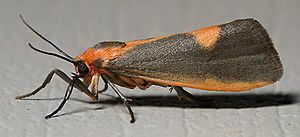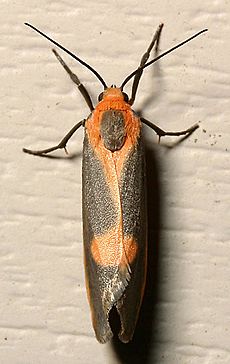Lead-colored lichen moth facts for kids
Quick facts for kids Lead-colored lichen moth |
|
|---|---|
 |
|
| Scientific classification | |
| Synonyms | |
|
The lead-colored lichen moth (scientific name: Cisthene plumbea) is a small moth that belongs to the Erebidae family. It was first described by a scientist named Richard Harper Stretch in 1885. This interesting moth gets its name from its lead-like, dull gray color.
Contents
About the Lead-Colored Lichen Moth
The lead-colored lichen moth is a fascinating insect found in North America. It's known for its unique appearance and its special diet. These moths are an important part of their ecosystem.
Where Do They Live?
You can find the lead-colored lichen moth in many parts of eastern North America. Their home range stretches from southern New Jersey down to northern Florida. They also live as far west as Wisconsin and Texas. This wide range means they can adapt to different environments.
What Do They Look Like?
These moths are quite small. Their wingspan (the distance from one wingtip to the other) is usually between 17 and 21 millimeters. That's about the size of a small coin! They have a distinct lead-gray color, which helps them blend in with their surroundings.
Their Life Cycle
Adult lead-colored lichen moths are typically seen flying from June to September. In most areas where they live, they have two "generations" each year. This means they complete their life cycle (egg, larva, pupa, adult) twice in one year. In warmer places like Louisiana, they can even have three generations annually!
What Do They Eat?
The larvae, or caterpillars, of the lead-colored lichen moth have a very specific diet. They love to munch on lichen. Lichen is a unique organism that grows on rocks, trees, and other surfaces. This special diet is why they are sometimes called "lichen moths."


